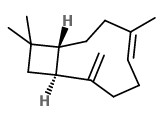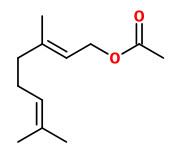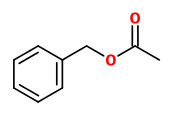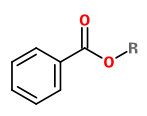Dies ist eine alte Version des Dokuments!
Cananga odorata (Lam.) Hook.f. & Thomson - Annonaceae - ylang-ylang, cananga, Ylang-Ylang
Fast growing tree, native to Malaysia, naturalized in South India, Java, Philippines; leaves oblong-obovate, glossy above, slightly pubescent beneath; flowers very fragrant, greenish to yellowish, many, hanging; fruit to 2.5 cm long, greenish, oblong-cylindric.
„Ylang-ylang oil (CAS 83863-30-3) is obtained by steam distillation from the flowers of the tropical ylang-ylang tree (var genuina). Ylang oil is used in the preparation of perfumes (for example, Chanel N°5), perfumed soaps, and in aromatherapy. In many countries it is considered a medicinal oil.“ http://de.wikipedia.org/wiki/Ylang-Ylang-%C3%96l
„The main components of ylang-ylang, first grade, are linalool (19%), β-caryophyllene (10.7%), germacrene D (10.3%), geranyl acetate (7.8%), benzyl acetate (4.6%), p-methylanisole (8.4%), benzyl benzoate (7.6%), and methyl benzoate (3.6%). The presence of these components and others in less amount are characteristic of the complex aroma of ylang-ylang that is a combination of floral, fruity, woody, and medicinal notes.“
[Gaydou, Emile M., Robert Randriamiharisoa, and Jean Pierre Bianchini. „Composition of the essential oil of ylang-ylang (Cananga odorata Hook Fil. et Thomson forma genuina) from Madagascar.“ J. Agric. Food Chem 34.3 (1986): 481-487]
„Steam distillation (SD), simultaneous distillation-solvent extraction (SDE), and supercritical (CO2) extraction (SFE) were used to isolate volatile secondary metabolites from fresh, totally mature flowers of Colombian ylang-ylang (Cananga odorata)… The main constituents of these extracts were linalool (20.7, 28.0, and 16.5%), germacrene-D (10.1, 3.1, and 20.3%) benzyl benzoate (14.1, 2.9, and 3.9%), benzyl acetate (9.6, 17.0, and 6.2%), caryophyllene (3.1, 2.9, and 3.9%), and p-methylanisole (6.8, 6.1, and 2.7%).“
Other components of first-grade oils were e.g. α-pinene (0.1-1.8%), p-cresol (0.02-0.5%), methyl benzoate (2.4-5.0%), methyl salicylate (0.03-0.28%), (E)-anethol (0.17-0.38%), methyl anthranilate (traces), eugenol (traces), geranyl acetate (1.0-2.8%), cinnamyl acetate (1.4-4.0%), (E,E)-farnesene (0.8-14.6%), nerolidol (0.02-0.35%), benzyl salicylate (2.3-3.6%), …
[HRGC/FID/NPD and HRGGC/MSD study of Colombian ylang-ylang (Cananga odorata) oils obtained by different extraction techniques. Elena E. Stashenko, Nubia Quiroz Prada, Jairo R. Martínez, Journal of High Resolution Chromatography, 1996, Vol.19 (6), 353-358]
„Ylang-ylang and cananga oils are essential oils that are obtained from two subspecies of the cananga tree.
1. Ylang-ylang oils are obtained by steam distillation of freshly picked blossoms of Cananga odorata
(DC.) Hook. f. et Thomson subsp. genuina (Annonaceae). These cananga trees normally grow to a height of 20m but are pruned to a height of 1.60-1.80m and flower throughout the year. The oil is produced mainly in Madagascar and the Comoro Islands. Four fractions are collected at progressively longer distillation times and are known as “Extra,” “I,” “II,” and “III.” Occasionally, a first fraction called “Extra superior” is collected. They are all pale to dark yellow liquids with a characteristic floral, spicy, balsamic odor. The first fractions are the most valuable; they have a higher density and a higher saponification number… The compositions of the various oil fractions depend on the duration of distillation. The first fraction, ylang-ylang oil Extra, has the highest content of strongly odoriferous constituents such as p-cresyl methyl ether (p-methyl-anisole, 5-16%), methyl benzoate (4-9%), (-)-linalool (7-24%), benzyl acetate (5.5-17.5 %), and geranyl acetate (2.5-14%). The other fractions contain increasing amounts of sesquiterpene hydrocarbons such as caryophyllene, germacrene-D, and (E,E)-α-farnesene (>70% in ylang-ylang III). Components such as p-cresol, eugenol, and isoeugenol are important for the odor, although they are present only in low concentration. Ylang-ylang Extra and I are used mostly in fine fragrances; ylang-ylang II and III are employed in soap perfumes.
2. Cananga oil is produced by steam distillation of the flowers of Cananga odorata (DC) Hook. f. et Thomson subsp. macrophylla. The yield, based on the weight of the flowers, is ca. 1%: The oil is a light to dark yellow liquid with a characteristic, floral, slightly woody odor. The qualitative composition of cananga oil resembles that of ylang-ylang III oil but is distinguished by its higher caryophyllene (30-40%) content.
Cananga oil originates almost exclusively in Java, where the flowers are collected throughout the year; annual production is ca. 50t. The oil is used mainly in perfuming soaps where it is more stable than ylang-ylang oils, due to its lower ester content.“
[H. Surburg und J. Panten: Common Fragrance and Flavor Materials: preparation, properties, and uses. Wiley-VCH, Weinheim 2006, ISBN 3-527-31315-X, S. 237-238]
The flower scent of Cananga odorata from Lakekamu (Papua Nueguinea) contained less p-methylansiole (4.2%) than usual, but in contrast, comparatively high levels of jasmone (0.2%), and methyl cis-(Z)-jasmonate (0.02%). Main components, trapped on Poropqaue Q, were linalool (24.0%), germacrene-D (21.0%), (E,E)-farnesene (12.2%), caryophyllene (7.0%), and benzyl acetate (6.8%).
[Meaningful Scents around the World, Roman Kaiser, Zürich 2006, 74-75 and 220-221]
Experiments with forty healthy volunteers to investigate the effects of ylang ylang oil (Cananga odorata, Annonaceae) on human physiological parameters (skin temperature, pulse rate, breathing rate and blood pressure) and self-evaluation after transdermal absorption showed that, „…at the behavioral level, subjects in the ylang ylang oil group rated themselves more calm and more relaxed than subjects in the control group. These findings are likely to represent a relaxing effect of the ylang ylang oil and provide some evidence for the usage of the ylang ylang oil in aromatherapy such as causing a relief of depression and stress in humans.“
[Hongratanaworakit, Tapanee, and Gerhard Buchbauer. „Relaxing effect of ylang ylang oil on humans after transdermal absorption.“ Phytotherapy Research 20.9 (2006): 758-763]

Blanco, M., Flora de Filipinas, t. 221 (1875)
http://plantgenera.org/species.php?id_species=189259

ylang-ylang flowers
CC BY-SA 2.0, Author: Bordy Nathalie Wikimedia Commons






